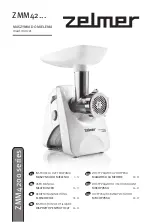
-14-
Excessive or sudden pres-
sure on the wheel will slow
grinding action and put dangerous stresses on
the wheel.
When grinding with a new wheel be certain to
grind while pulling tool backwards until wheel
becomes rounded on its edge. New wheels
have sharp corners which tend to “bite” or cut
into work piece when pushing forward.
CUTTING METAL
Using the optional type 1A wheel guard, it is
possible to perform limited cutting on small
stock such as metal tubes, piping or rebar.
When cutting, work with moderate feed,
adapted to the material being cut. Do not
exert side pressure onto the cutting disc, tilt
or oscillate the tool. When cutting profiles
and square bar, it is best to start at the
smallest cross section.
Always follow precautions for kickback.
Do not apply side pressure to cutting wheel
to reduce wheel speed.
The tool should always be used so that
sparks are directed away from user.
CUTTING MASONRy
Operate the tool only with dust extraction and
additionally wear a dust protection mask. The
vacuum used for this application must be
approved for the extraction of masonry dust.
Bosch sells suitable vacuum cleaners.
When cutting masonry
always use dust extraction
with foot plate. The tool may be used only for
dry cutting. When cutting masonry use a dry
diamond wheel.
Always cut towards the dust extraction port
(Fig. 9).
Turn the tool on and place the front part of the
cutting guide on the workpiece. Slide the tool
with moderate rate of feed, adapted to the
material to be cut.
When doing deep cuts, it is best to cut in
several shallow passes.
When cutting especially hard material, e. g.,
concrete with high pebble content, the dry
diamond wheel can overheat and become
damaged. This is clearly indicated by circular
sparking of the rotating dry diamond wheel.
In this case, interrupt the cutting process and
allow the dry diamond wheel to cool by running
the tool for a short time at maximum speed
with no load.
Noticeable decreasing work progress and
circular sparking are indications of a dry
diamond wheel that has become dull. Briefly
cutting into abrasive materials (e. g. brick) can
resharpen the wheel again.
!
WARNING
FIG. 9
!
WARNING
Sanding Operations
SELECTING SANDING DISC
Sanding discs are made of extremely hard
and sharp aluminum oxide grits, phenol-resin
bonded to a sturdy fiber backing for fast
heavy-duty service and long life. The discs
vary as to size and spacing of the abrasive
grits. OPEN COAT (type H) — used for soft
materials and on paint or varnish. CLOSED
COAT (type K) —used for metal, hardwood,
stone, marble and other materials.
Sanding discs range in grit from 16 (very
coarse) to 180 (very fine). To obtain best
results, select sanding discs carefully. Many
jobs require the use of several grit sizes and
at times both “open coat and closed coat”
discs are required to get the job done faster.
See chart for application examples.
Operation:
Refinishing painted wood or metal surfaces.
REMARKS
GRIT
To remove paint and to smooth
Coarse
surface irregularities.
16-24-30
To smooth
Medium
the rough sanding.
36-50-80
To remove scratches left by
Fine
previous discs.
100-120
To smooth surfaces for painting,
Very Fine
polishing or waxing.
150-180
BM 2610034439 04-14_CAG180 4/1/14 7:26 AM Page 14















































